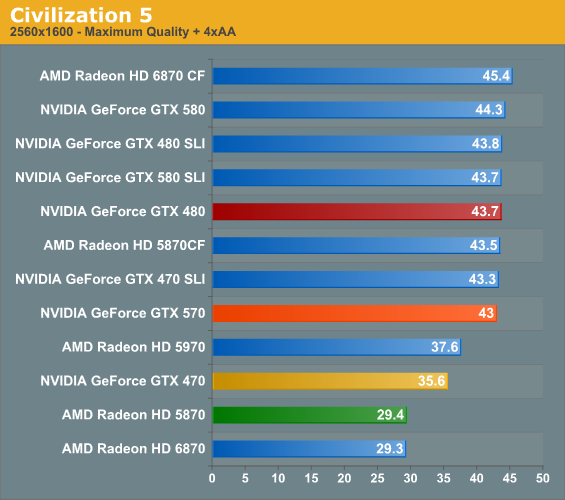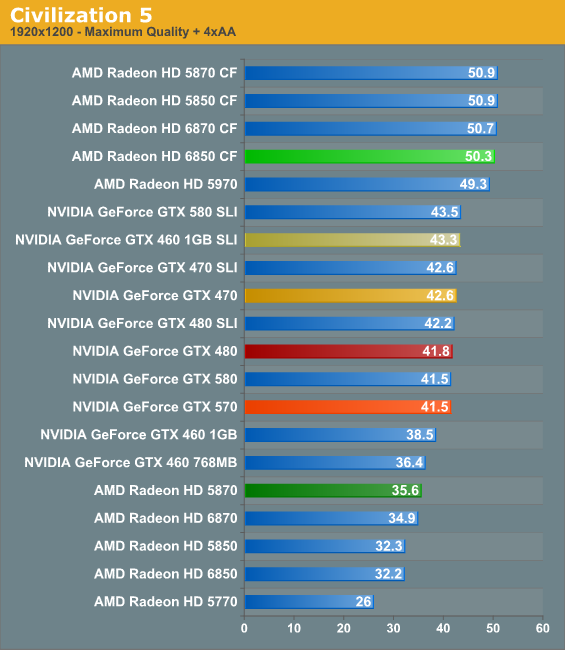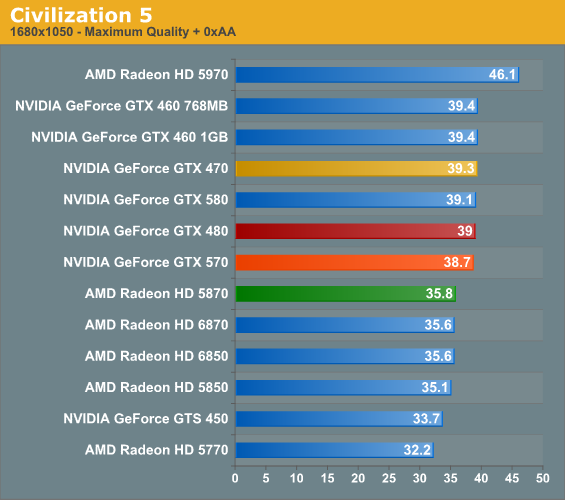NVIDIA's GeForce GTX 570: Filling In The Gaps
by Ryan Smith on December 7, 2010 9:00 AM ESTCivilization V
The other new game in our benchmark suite is Civilization 5, the latest incarnation in Firaxis Games’ series of turn-based strategy games. Civ 5 gives us an interesting look at things that not even RTSes can match, with a much weaker focus on shading in the game world, and a much greater focus on creating the geometry needed to bring such a world to life. In doing so it uses a slew of DirectX 11 technologies, including tessellation for said geometry and compute shaders for on-the-fly texture decompression.



Civ 5 is a very interesting game for us. It’s one of the few games we’ve ever tested where performance increases with resolution, something we’re content to attribute to its unique use of DX11 features and what may be a better match between tessellated triangles and 16 pixel quads at higher resolutions. The result is that while it’s CPU limited most of the time, there’s very little reason to not crank up the resolution to your monitor’s native resolution.
Because we’re CPU limited several things are going on. Until we hit 2560 the 470, 480, 570, and 580 are all effectively tied with each other, with the 470 finally falling behind in the end. As a result at 2560 it appears that a GTX 570 is all that’s necessary to take full advantage of the game. Meanwhile NVIDIA has always done better than AMD here in single-GPU scenarios, so the Radeon 5870 is nearly 20% behind the GTX 570. On the flip side the 6850CF shoots well ahead of the GTX 570, hitting what appears to be the cap for AMD cards at around 51fps.










54 Comments
View All Comments
xxtypersxx - Tuesday, December 7, 2010 - link
If this thing can hit 900mhz it changes the price/performance picture entirely, why no overclock coverage in such a comprehensive review?Otherwise great write up as always!
Bhairava - Tuesday, December 7, 2010 - link
Yes good point.vol7ron - Tuesday, December 7, 2010 - link
Why do graphics cards cost more than cpu+mobo these days?I know there's a different design process and maybe there isn't as much an economy of scale, but I'm just thinking about the days when it was reverse.
Klinky1984 - Tuesday, December 7, 2010 - link
Well you're essentially buying a computer on a card with a CPU these days. High performance GPU w/ high performance, pricey ram, all of which needs high quality power components to run. GPUs are now computers inside of computers.lowlymarine - Tuesday, December 7, 2010 - link
I think it's simply that GPUs can't get cheaper to the extent that CPUs have, since the die sizes are so much larger. I certainly wouldn't say they're getting MORE expensive - I paid $370 for my 8800GTS back in early 2007, and $400 for a 6800 in early 2005 before that.DanNeely - Tuesday, December 7, 2010 - link
High end GPU chips are much larger than high end CPUchips nowdays. The GF110 has 3bn transistors. For comparison a quadcore i7 only has 700m, and a 6 core athlon 900m, so you get 3 or 4 times as many CPUs from a wafer as you can GPUs. The quad core Itanic and octo core I7 are both around 2bn transistors but cost more than most gaming rigs for just the chip.GDDR3/5 are also significantly more expensive than the much slower DDR3 used by the rest of the computer.
ET - Tuesday, December 7, 2010 - link
They don't. A Core i7-975 costs way more than any graphics card. A GIGABYTE GA-X58A-UD9 motherboard costs $600 at Newegg.ET - Tuesday, December 7, 2010 - link
Sorry, was short on time. I'll add that you forgot to consider the price of the very fast memory on high end graphics cards.I do agree, though, that a combination of mid-range CPU and board and high end graphics card is cost effective.
mpschan - Wednesday, December 8, 2010 - link
Don't forget that in a graphics card you're getting a larger chip with more processing power, a board for it to run on, AND memory. 1GB+ of ultra fast memory and the tech to get it to work with the GPU is not cheap.So your question needs to factory in cpu+mobo+memory, and even then it does not have the capabilities to process graphics at the needed rate.
Generic processing that is slower at certain tasks will always be cheaper than specialized, faster processing that excels at said task.
slagar - Wednesday, December 8, 2010 - link
High end graphics cards were always very expensive. They're for enthusiasts, not the majority of the market.I think prices have come down for the majority of consumers. Mostly thanks to AMDs moves, budget cards are now highly competitive, and offer acceptable performance in most games with acceptable quality. I think the high end cards just aren't as necessary as they were 'back in the day', but then, maybe I just don't play games as much as I used to. To me, it was always the case that you'd be paying an arm and a leg to have an upper tier card, and that hasn't changed.